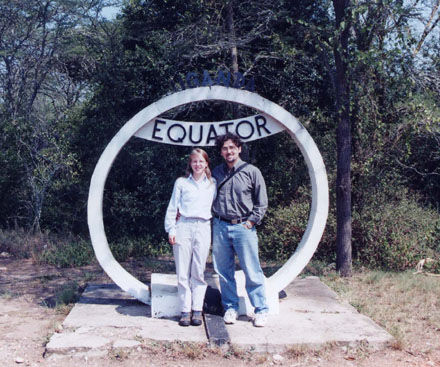Completed projects, publications, former students
Master's research
My interests in hydrogen sulfide were sparked during my Master's studies at Washington State University. Ray Lee (who is retired from WSU) and I explored whether sulfur-containing free amino acids, such as taurine and thiotaurine, can be used to aid in sulfide detoxification. We did this work in the clam Solemya velum (supplied by Marine Biological Labs, see picture from MBL) which harbors chemoautotrophic symbionts that are very similar to those found in organisms from deep sea hydrothermal vents.
Joyner, JL, Peyer, SM, and Lee, RW. 2003. Possible roles of sulfur-containing amino acids in a chemoautotrophic bacterium/mollusc symbiosis. The Biological Bulletin 205:331-338.
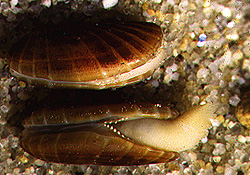
Doctoral research
I continued to work with hydrogen sulfide during my doctoral studies with David Julian (University of Florida). We determined that exposure to sulfide induces an oxidative stress 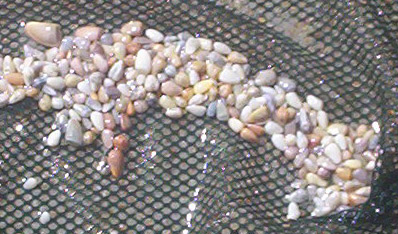 response in an aquatic invertebrate that is not sulfide-tolerant (the bivalve, Donax variabilis, pictured to right). These clams live on high energy sandy beaches where they likely are not exposed to sulfide. When the clams were brought into the lab and exposed to relatively low levels of sulfide for several days, they upregulated their expression levels of several stress proteins that are indicative of an oxidative stress response. These results suggest that the sulfide can alter free radical metabolism.
response in an aquatic invertebrate that is not sulfide-tolerant (the bivalve, Donax variabilis, pictured to right). These clams live on high energy sandy beaches where they likely are not exposed to sulfide. When the clams were brought into the lab and exposed to relatively low levels of sulfide for several days, they upregulated their expression levels of several stress proteins that are indicative of an oxidative stress response. These results suggest that the sulfide can alter free radical metabolism.
Joyner-Matos, J, Downs, CA, and Julian, D. 2006. Increased expression of stress proteins in the surf clam Donax variabilis following hydrogen sulfide exposure. Comparative Biochemistry and Physiology 145:245-257.
In another project, we explored whether functional and cellular-level biomarkers can be useful in determining the health of the stress tolerant bivalve, Mercenaria mercenaria (pictured to the right).  These clams are an important aquaculture species in several states, including Florida. Southern Cross Sea Farms Inc. in Cedar Key, FL generously donated the clams for this study and us on several excellent tours of the hatchery (see picture of the Mercenaria group with Bill, the guru of all things clam). Several undergraduate students participated for multiple years in this study, including Jenessa Andrzejewski, Laura Briggs, Jennifer Rivas, and Michaela Hogan, all of whom continued on to multiple graduate/clinical degrees!
These clams are an important aquaculture species in several states, including Florida. Southern Cross Sea Farms Inc. in Cedar Key, FL generously donated the clams for this study and us on several excellent tours of the hatchery (see picture of the Mercenaria group with Bill, the guru of all things clam). Several undergraduate students participated for multiple years in this study, including Jenessa Andrzejewski, Laura Briggs, Jennifer Rivas, and Michaela Hogan, all of whom continued on to multiple graduate/clinical degrees!
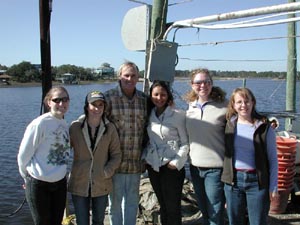
Joyner-Matos, J, Andrzejewski, J, Briggs, L, Baker, SM, Downs, CA, and Julian, D. 2009. Assessment of cellular and functional biomarkers in bivalves exposed to ecologically-relevant abiotic stressors. Journal of Aquatic Animal Health, 21:104-116.
We also explored the physiology of the marine annelid Glycera dibranchiata (pictured to right). These worms are collected from sulfidic mudflats along the northeastern Atlantic coast. In a recent study we found that worms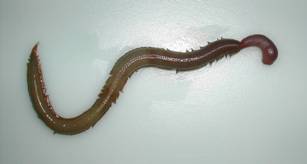 exposed to ecologically relevant sulfide levels had elevated levels of free radical production in their coelomocytes ("blood" cells) and elevated oxidatively damaged DNA and RNA in their body wall tissue and coelomocytes. Early Glycera work was conducted with Rajat Bhalla while he was a high school student participating in the UF Student Science Training Program (Rajat was a semifinalist in the 2003 Siemens Westinghouse competition and the 2004 Intel Science Talent Search with this project, now recently graduated from MIT and applying to medical school). Sulfide work was conducted with Jenny Stein (undergraduate student at UF, now employee of a biotech firm) and Ben Predmore (now a postdoc at Emory).
exposed to ecologically relevant sulfide levels had elevated levels of free radical production in their coelomocytes ("blood" cells) and elevated oxidatively damaged DNA and RNA in their body wall tissue and coelomocytes. Early Glycera work was conducted with Rajat Bhalla while he was a high school student participating in the UF Student Science Training Program (Rajat was a semifinalist in the 2003 Siemens Westinghouse competition and the 2004 Intel Science Talent Search with this project, now recently graduated from MIT and applying to medical school). Sulfide work was conducted with Jenny Stein (undergraduate student at UF, now employee of a biotech firm) and Ben Predmore (now a postdoc at Emory).
Joyner-Matos, J, Predmore, BL, Stein, JR, Leeuwenburgh, C, and Julian, D. 2010. Hydrogen sulfide induces oxidative damage to RNA and DNA in a sulfide-tolerant marine invertebrate. Physiological and Biochemical Zoology. 83:356-365.
Joyner-Matos, J, and Julian, D. 2011 Oxidative Stress in Sulphidic Habitats. In: Oxidative Stress in Aquatic Habitats, T Zenteno-Savin and D Abele (Eds). Wiley Blackwell Publishers. Link to Wiley's web page for our book. 
Postdoctoral research
This work was conducted in collaboration with my postdoctoral advisor, Charlie Baer (University of Florida) and his lab of expert worm-pickers (pictured to right circa 2007). 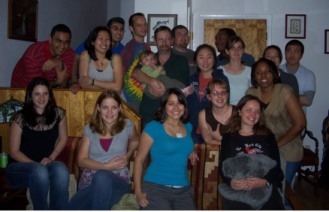 Charlie is an evolutionary geneticist who studies the evolution of mutation, particularly mutation rate and spectrum. Much of this work is done in rhabditid nematodes, particularly those in the genus Caenorhabditis (pictured above). During my postdoc, we explored the effects of spontaneous mutations on lifespan in C. elegans and C. briggsae. This project was the beginning of an in-depth project exploring the effects of mutations on worm physiology, particularly physiology related to free radical metabolism (see research page).
Charlie is an evolutionary geneticist who studies the evolution of mutation, particularly mutation rate and spectrum. Much of this work is done in rhabditid nematodes, particularly those in the genus Caenorhabditis (pictured above). During my postdoc, we explored the effects of spontaneous mutations on lifespan in C. elegans and C. briggsae. This project was the beginning of an in-depth project exploring the effects of mutations on worm physiology, particularly physiology related to free radical metabolism (see research page).
Joyner-Matos, J, Upadhyay, A, Salomon, M, Grigaltchik, V, and Baer, CF. 2009. Genetic (co)variation for life span in rhabditid nematodes: Role of mutation, selection, and history. Journals of Gerontology: Biological Sciences, 64:1134-1145.
Baer, CF, Joyner-Matos, J, Grigaltchik, V, Salomon, MP, Upadhyay, A. 2010. Rapid decline in fitness of mutation accumulation lines of gonochoristic (outcrossing) caenorhabditis nematodes. Evolution, 64:3242-3253. DOI: 10.1111/j.1558-5646.2010.01061.x
Etienne, V, Anderson, EC, Ponciano, JM, Blanton, D, Cadavid, A, Joyner-Matos, J, Matsuba, C, Tabman, B, and Baer, CF. 2014. The red death meets the abdominal bristle: Polygenic mutation for susceptibility to a bacterial pathogen in Caenorhabditis elegans. In press, Evolution.
Undergraduate research
While I was an undergraduate student, I worked for four years in an immunology lab at the UofU School of Medicine. Much of our research explored the neonatal immune response to group B streptococci bacteria. My portion of the research program focused on cytokine production, particularly the Th1-type cytokines.
La Pine, TR, Joyner, JL, Augustine, NH, Kwak, SD, and Hill, HR. 2003. Defective production of IL-18 and IL-12 by cord blood mononuclear cells influences the T helper-1 interferon gamma response to group B streptococci. Pediatric Research 54:276-281.
Kwak, DJ, Augustine, NH, Borges, WG, Joyner, JL, Green, WF, and Hill, HR. 2000. Intracellular and extracellular cytokine production by human mixed mononuclear cells in response to group B streptococci. Infection and Immunity 68:320-327.
Joyner, JL, Augustine, NH, Taylor, KA, La Pine, TR, and Hill, HR. 2000. Effects of group B streptococci on cord and adult mononuclear cell mRNA accumulation and protein secretion of IL-12 and IFN-gamma. Journal of Infectious Diseases. 182:974-977.
